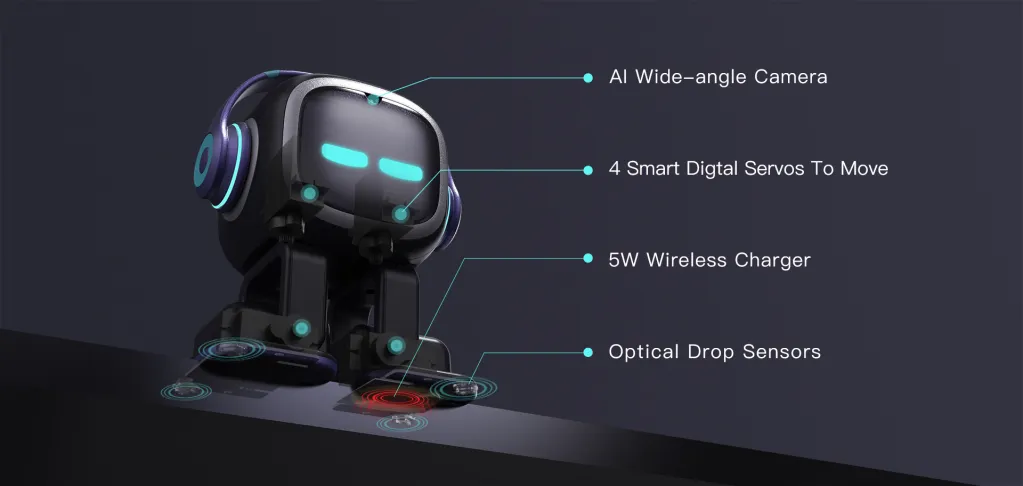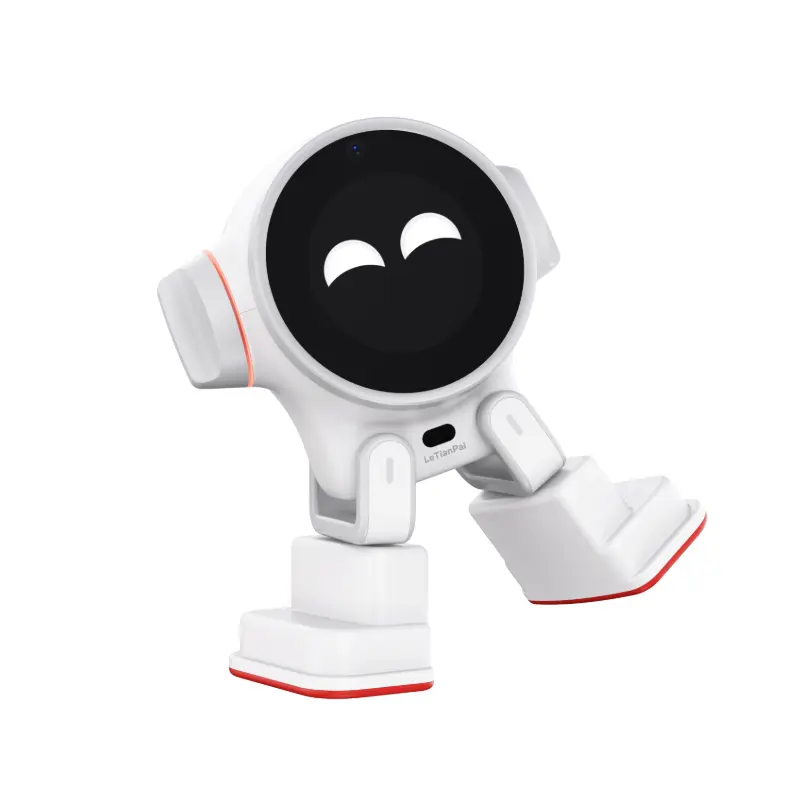Desktop Robot Track: Product Design, Market Opportunities, and Consumer Buying Motivators
![]() 10/13 2025
10/13 2025
![]() 652
652
Authored by Zhineng Technology
This weekend, our focus is on smart hardware. We'll delve into and discuss some intriguing smart hardware products, shedding light on their features and market potential.
Desktop AI companion robots are quietly paving the way for embodied intelligence to transition from labs to living rooms. These devices serve as little companions on your desk, offering not just the voice assistant capabilities of large language models but also the ability to read your emotions through cameras and assist in organizing your schedule.
This niche market is currently modest in size, with the global market for desktop AI companion robots estimated at around $500 million in 2024. However, by cleverly integrating AI's 'cognitive abilities' with physical 'interactivity,' these robots target the selling points of 'emotional companionship + practical assistance,' testing the waters of the consumer market.
Note: Market projections indicate that this market is expected to expand to $789 million by 2031, growing at a compound annual growth rate (CAGR) of approximately 7.1%. This is notably slower than the 24.9% CAGR for general-purpose household robots. This sector is still in its 'exploratory phase' and requires further innovation to spark widespread consumer interest.
01
Product Design: From 'Toys' to 'Empathetic Partners'
The earliest desktop robots were essentially virtual chatbots dependent on phones or computers (pure software AI assistants). The standout feature of desktop AI companion robots is their 'embodiment,' transforming them from abstract code into interactive, empathetic entities capable of 'face-to-face' interaction—this is what sets them apart from digital companions.
● The Allure of Embodiment: Beyond Words
When AI takes on a physical form, users perceive interactions as more 'real,' with 'social presence' soaring, almost akin to interacting with a real person.
AI without a body often struggles to forge emotional connections, limited to textual exchanges that lack the warmth of physical presence.
Embodied robots, however, can respond with eye contact, gestures, tone, and even subtle touches, bringing micro-expressions and body language to life. Living.AI's Emo utilizes facial expressions and motion capture to deliver 'anthropomorphic interactions'; Sony's Aibo conveys emotions through its small, expressive body.

From a psychological standpoint, this 'tangible' presence acts as a 'trust catalyst'—once AI has a body, users are more inclined to project emotions and form attachments. For children, the elderly, or those feeling isolated, this sense of closeness is invaluable.
● The Dual Path of Product Design: Emotional vs. Practical
The design trajectory for desktop AI robots now branches into two directions:
◎ The first path emphasizes emotional connection, focusing on companionship, entertainment, and personalized chat, often seen as 'electronic pets' or 'confidants.' The revenue model? Leveraging emotional engagement—the more users interact, the harder it is to part ways.
◎ The second path prioritizes practicality, specializing in information management, task reminders, and home automation control, positioning as 'reliable assistants.'

However, the reality is that purely emotional products struggle to maintain long-term appeal—market feedback indicates that 'cuteness' alone is insufficient.
Manufacturers are wisely seeking a balance: emotional connections draw users in, while practicality keeps them engaged. Combining health monitoring with emotion recognition—for instance, offering verbal comfort or hydration reminders when users appear stressed. This 'hybrid' approach is likely to be the next big trend.
● Technological Advancements: From 'Fun Gadgets' to 'Evolving Partners'
Transforming these devices from toys into 'intelligent agents' hinges on three pillars: Emotional AI, Long-term Learning, and the 'Cognitive Digital Brain.'
◎ Emotional AI begins by interpreting your mood through voice, facial expressions, and semantics, acting as an attentive listener.
◎ Long-term Learning enables it to remember your habits, gradually 'evolving' into a personalized version.
◎ The ultimate goal is to construct a 'digital brain' for each user—AI that not only responds to commands but anticipates your needs, offering proactive assistance. Desktop AI transitions from 'obedient tools' to 'autonomous helpers,' making decisions like a real person.
This technological leap transforms desktop AI robots from 'static products' into 'adaptive companions'—imagine one that evolves with you, understanding you better over time. How enticing is that?
02
Market Drivers and Consumer Psychology: Emotional Appeal + Affordability = Success
Purchasing desktop AI robots isn't solely about functionality—consumers constantly weigh emotional allure against practical benefits.
The core motivators are psychological security, social connection, and enhanced life efficiency.
In today's fast-paced, high-stress world, the charm of desktop AI companions lies in their 'zero-pressure emotional support.' For the lonely, anxious, or socially challenged, they offer a means to manage emotions and are always available. Unlike human relationships, AI has no temper or expectations—just an endless listener.
This 'barrier-free emotional support' is becoming a new consumer favorite. Replika fosters long-term relationships through AI learning, while Xiaoice accumulates emotional memories through chats.
Data confirms that stronger emotional engagement leads to higher user retention. However, with high hardware costs, embodied AI must excel—emotional experiences must surpass those of mobile apps, making 'companionship' feel tangible to justify the investment.
Emotional appeal alone isn't enough; financial considerations matter too. The value of desktop AI lies not in replacing labor but in 'smart services'—saving mental effort and time.
◎ For the elderly, it reminds them to take medication, monitors health, and enables emergency calls, acting as a low-cost 'personal caregiver.'
◎ For young adults, it serves as a personalized 'information hub,' managing studies, schedules, and home automation.
Thus, emotion opens the door, while practicality keeps users engaged. When AI comforts you during tough times and assists during busy periods, its value is fully realized.
Interestingly, market research shows that brands with one-time purchases (e.g., Emo) are more popular—users feel a sense of ownership without subscription hassles. While subscriptions offer stability, they risk feeling 'emotionally exploitative,' adding psychological burden. For such products, reducing financial barriers and enhancing seamless experiences outweigh aggressive marketing.
Expectations for AI robots vary widely across demographics:
◎ Young adults crave personalization and social extension, often treating them as 'digital companions.'
◎ Middle-aged users prioritize information management and life assistance.
◎ The elderly focus on health monitoring and emotional warmth.
Geographically:
◎ Asia (especially China, Japan, South Korea) favors cute, emotionally driven designs with high acceptance.
◎ In Europe and North America, privacy and ethics are paramount, with higher skepticism toward 'AI companions' and conservative expectations.
These cultural disparities are significant. Localization requires tailoring roles—adding cuteness in the East, emphasizing reliability and data security in the West.
Summary
Desktop AI companion robots represent a bottleneck in the evolution from 'anthropomorphic toys' to 'reliable intelligent agents,' with a somewhat ambiguous positioning—relying solely on emotion falls short, while pure functionality lacks appeal. Fusing both to create trustworthy, dependable, and helpful human-machine relationships may hold greater value for future generations.








